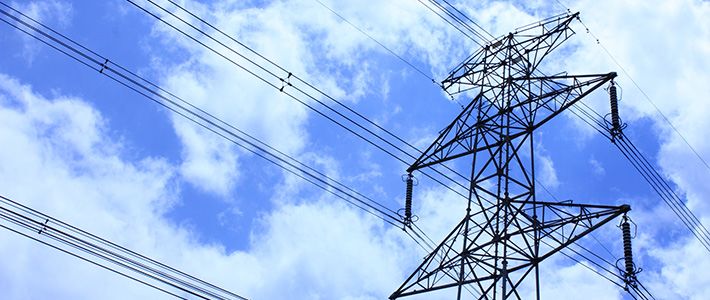
Energy Policy: Japan at the Crossroads
Examining Japan’s Energy Choices
Politics Economy- English
- 日本語
- 简体字
- 繁體字
- Français
- Español
- العربية
- Русский
On June 29, 2012, more than 15 months after the accident at Fukushima Daiichi Nuclear Power Station, the government’s Energy and Environment Council issued its “Options for Energy and the Environment.” This document spelled out three scenarios for consideration during the crafting of a new long-term energy strategy for the nation. The Strategic Energy Plan in effect prior to the March 11 disaster, approved by the cabinet in 2010, called for the nation to generate roughly 50% of its electricity using nuclear power by 2030. The three scenarios in the 2012 document, however, envision a much smaller role for nuclear power in meeting Japan’s electricity needs: either 0%, 15%, or 20%–25%, all dependent on an overall reduction in electricity consumption of some 10%. This reduced dependence on nuclear power is reflected in greater roles for renewables and fossil fuels. In these three scenarios, renewable energy sources are expected to provide 35%, 30%, or 25%–30% of Japan’s electricity, respectively, while fossil fuels are expected to generate 65%, 55%, or 50% of the nation’s power. Table 1 gives an overview of the three scenarios in “Options for Energy and the Environment.”
Today Japan faces a number of challenges—how to increase its energy self-sufficiency, how to keep its economy growing, and how to address global environmental problems—as it charts its optimal energy mix for the future. In this essay we will examine the significance of the choices the nation has set for itself with a view to narrowing them down to the best option for Japan.

Choosing an Energy Mix
In selecting the best energy mix for the future, Japan must consider its choices carefully from what can be called the “3E+S+M” perspectives. These five perspectives are:
(1) Energy security (E1)
As a nation with no energy resources to speak of (energy self-sufficiency currently stands at just 4%), Japan needs to position its energy security as a core factor in measures necessary to support its people’s daily lives and economic activities.
(2) Environment (E2)
Some 90% of the greenhouse gases produced by human activity are carbon dioxide emitted during energy generation. Energy policy is inextricable from the global warming problem, and an integrated approach is required that takes both sides into account.
(3) Economic efficiency (E3)
A stable, affordable supply of energy is a must to ensure reliable livelihoods for the people and maintain industrial competitiveness.
(4) Safety (S)
Sufficient consideration must also be given to the safety of energy use and provision.
(5) Macroeconomic impact (M)
Some policy choices have the potential to negatively impact the lives of some of Japan’s people or some economic activities in the country; there is a need to keep this impact (rising electricity costs, lower GDP growth, and the like) to as low a level as possible.
The various energy sources at Japan’s disposal all have different characteristics, and none of them are perfect—they all have negative factors of some kind. In the following we review potential sources of energy, looking at the advantages and challenges associated with their use, from the 3E+S+M perspectives.
Renewable energy
The greatest benefit of renewable energy sources is clear from perspective E1. Renewables represent a purely Japanese source of power, contributing to the nation’s energy self-sufficiency. They are also a positive in terms of perspective E2, as no greenhouse gases are emitted during electricity generation from these sources. On the other hand, though, renewables come at a higher cost than thermal and nuclear power, and their lower energy density means that more land is required for facilities producing the same amount of electricity with them. Solar and wind power can also fluctuate considerably, making them inappropriate for use as a baseload power source; they must be accompanied by additional sources of power to ensure a stable supply in the electric grid. These are all negative factors when viewed from perspective E3.
The 0% scenario, for instance, where renewables supply 35% of Japan’s electricity in 2030, will require the installation of solar panels on every home in Japan where it is feasible to do so; seismic retrofitting will also be required in homes that are insufficiently earthquake-resistant to bear the additional load of the solar equipment. Calculations also show that the wind power facilities Japan will have to construct will occupy a total area 2.2 times larger than the Tokyo Metropolitan area. And failure to reach these targets will result in additional reliance on thermal power generation to make up the shortfall, thus erasing the environmental benefit brought by the renewables.
Thermal energy
The primary benefit of thermal energy sources, such as fossil fuels, is their convenience for generating electricity. Just about any type of fuel, once procured, can be used flexibly and economically to cover base-load, middle-load, and peak-load electricity demand. However, Japan must import nearly all of the fossil fuels it uses, leaving the nation seriously exposed to geopolitical risk in petroleum-supplying regions like the Middle East (perspective E1). Moreover, since the cost of fuel accounts for 70%–80% of the cost of thermal power generation, these sources are not so stable, economically speaking; the cost of thermal generation can vary greatly when those fuel prices fluctuate (perspective E3). Thermal power generation also emits large quantities of greenhouse gases, making it necessary to tack on additional measures like carbon capture and storage—making this a concern from perspectives E2 and E3.
Nuclear energy
The greatest benefits of nuclear power are evident from perspective E1: the tremendous generation capacity of a single power plant, the abundance of the resources needed to produce it and the ease of stockpiling them, and its position as a quasi domestic source of power (with Japan able to provide its own fuel at this point), making it a great contributor to Japan’s energy security. Like renewable sources, nuclear power also produces no greenhouse gases in the generation phase, making it a positive choice from perspective E2 as well. When used safely and stably over the long term, nuclear power is cheaper than other power sources, even when taking into account the cost of land for generation facilities, the political cost, and the cost for decommissioning aged reactors and treating radioactive waste (perspective E3).
The downside to nuclear power—a matter of concern even before the March 11, 2011, disaster—falls under perspective S: the need for appropriate handling of the highly radioactive waste and for enhanced safety.
Figures 1 through 3 show the domestic production ratios (perspective E1), carbon dioxide emissions (perspective E2), and generation costs (perspective E3) for each energy source.
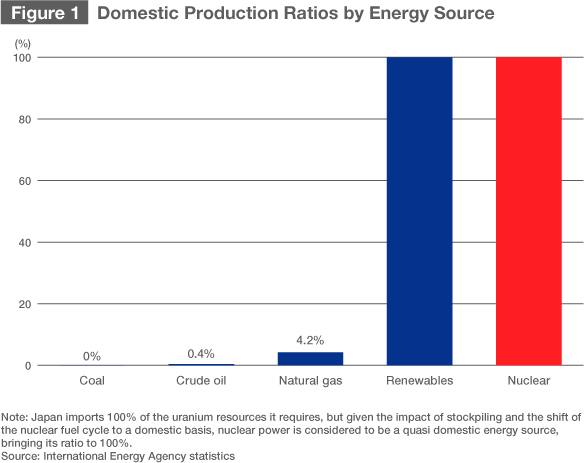
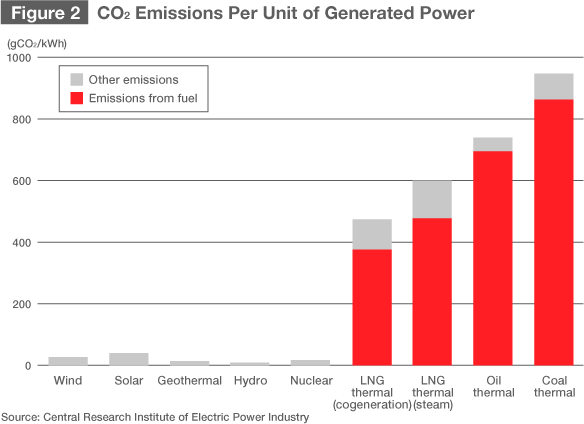
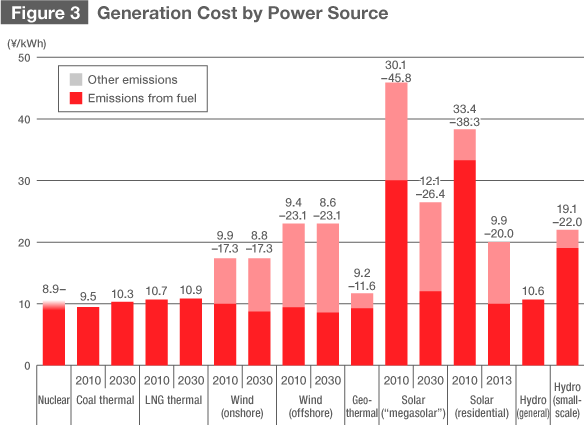
Notes: Lightly shaded portions of bars indicate ranges possible with cost reductions, etc. No upper range limit is given for nuclear power due to uncertainty over cost associated with accident risk.
Source: Data from Energy and Environment Conference Cost Verification Committee report, December 19, 2011 (Japanese only)
Evaluating the Scenarios
Building on the characteristics of and issues associated with the energy sources detailed above, we will next present our evaluations of each of the scenarios in the Energy and Environment Council report.
First, under the 20%–25% scenario, in which the share of renewables in the energy mix is more than doubled from the present (2010) level and nuclear power’s share is maintained or slightly decreased, Japan will be able to improve its energy self-sufficiency and reduce its spending on imported fuel. This scenario is also environmentally friendly while still featuring a relatively minimal impact on the nation’s economy.
Next, under the 15% scenario, which sees the share of nuclear power fall to around half of its present level, we see that Japan will be able to improve its self-sufficiency in energy, but at a greater economic cost than in the 20%–25% scenario. Under the 0% scenario, meanwhile, Japan will be unable to reduce its spending on imported fuel, and the environment will also bear the brunt of higher greenhouse gas emissions. The economic impact of this scenario will also extend to factors like higher electricity prices for consumers. In short, as the share of nuclear power in Japan’s energy mix goes down, the outlook becomes worse from the 3E perspectives of energy security, environment, and economic efficiency, and the negative impact grows larger from perspective M, the nation’s macroeconomic prospects. Table 2 presents an overview of the three scenarios from these 3E+M perspectives.
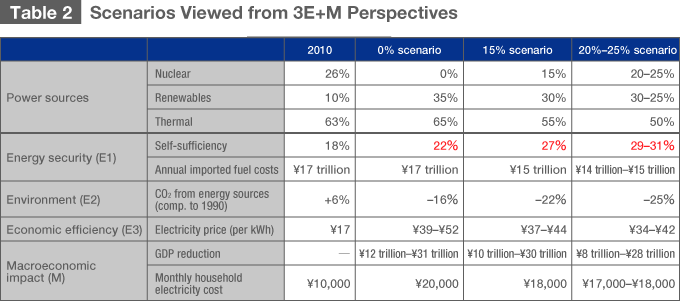
Notes: Self-sufficiency ratios are provisional figures for the three scenarios. To maintain consistency for the purpose of comparison, the 0% scenario is one involving no additional energy-efficiency measures (“option 1” calculated by the Fundamental Issues Subcommittee, Advisory Committee for Natural Resources and Energy, Ministry of Economy, Trade, and Industry). Data was also taken from two research organs using cost figures from the Energy and Environment Council’s Cost Verification Committee.
A Sustainable Role for Nuclear Power
Under the title “Options for Energy and the Environment,” on July 14, 2012, the government’s National Policy Unit started a series of hearings in locations around Japan. To date these have resulted in calls from many of the hearings to opt for the 0% scenario outlined above, a view espoused mainly on the basis of people’s shaken trust in the safety of nuclear power.
To date there have been four reports published on the accident at Fukushima Daiichi Nuclear Power Station: one from the government (available in Japanese only), one from the NAIIC (the National Diet of Japan Fukushima Nuclear Accident Independent Investigation Commission), the Fukushima Nuclear Accidents Investigation Report from TEPCO, the Tokyo Electric Power Co., and the report from the private-sector Rebuild Japan Initiative Foundation. These investigations all point to failure to act, on the part of both TEPCO and the regulatory authorities, as a reason that sufficient tsunami preparation measures were never implemented at Fukushima Daiichi. Public trust in nuclear power must now be restored through urgent safety improvements, stress testing to confirm the robustness of Japan’s power plants, and the establishment of a highly independent nuclear regulatory commission.
Let us take a closer look at the situation in Japan’s nuclear power plants prior to the Fukushima accident. While the facilities’ capacity factors were not as high as they could have been, their frequency of unplanned shutdowns was far lower than in other countries’ nuclear plants, as was their frequency of incidents meriting a score on INES, the seven-level International Nuclear and Radiological Event Scale. As unplanned shutdowns in Japan lead to considerable wait times before reactors can be restarted, the operators took careful steps to prevent even minor mishaps, for the most part.
Looking at the global industry, we see that even when Western nuclear firms lost their cost competitiveness and stopped investing in new plant construction during the 1980s, Japan was pressing ahead with new nuclear power stations and research and development with the aim of diversifying its energy mix. The result of this was a situation where out of the handful of the world’s main nuclear reactor builders—France’s Areva, Russia’s Rosatom, Mitsubishi, Hitachi-GE Nuclear Energy, and Toshiba Westinghouse—three are Japanese firms or alliances with Japanese involvement. Japan thus maintains a considerable presence in the global nuclear power industry. And nations like Vietnam and Lithuania, which are currently seeking to introduce nuclear power in their own energy mixes, remain willing to rely on these Japanese companies, even in the wake of the Fukushima disaster.
In the end, though, while Japan boasted impressive nuclear technology, we can say that the cause of the Fukushima accident lay in its lack of focus on the capabilities and safety of its organizations tasked with using and regulating that technology: in short, there was an insufficient culture of safety. By rebuilding this culture and improving governance through fully transparent regulatory organs, Japan could improve the safety standards of its nuclear power stations to an internationally high level. We must note that nuclear power was not selected for its inherent safety and reliability; Japan chose nuclear power based on its national energy situation, and it is vital that the nation use it as safely as possible. While recognizing the impossibility of reducing the risk of a serious incident to zero, people in the nuclear industry need to prepare multilayered steps and measures to take in the event that a major accident does take place—something that was sorely lacking before Fukushima. We strongly hope that they will develop an appropriate mindset and make ongoing efforts to improve their performance.
Keeping All Options On the Table
From the 3E+S+M perspectives, none of Japan’s energy options—renewables, nuclear, or thermal—is ideal in every respect. There is no perfect source of energy for Japan, a nation with few energy resources of its own. The best way forward is therefore to work with diverse sources of energy, maximizing their advantages and minimizing their disadvantages, using them in a well-balanced mix. If Japan does select the 0% scenario, it will need to do so with the full understanding of its people that this choice will entail burdens on their lives and an impact on the Japanese economy. If Japan is to reduce its dependence on fossil fuels and boost the use of renewables, it will also need to take a determined stance and find ways to do so without relying on government subsidies to increase renewable energy infrastructure.
We believe, however, that the ideal strategy for Japan is to discard none of the options available to it today. The nation must continue using and developing its realistically usable energy sources—nuclear, renewables, and thermal—while also pressing forward with research and development of potential energy sources of the future, such as hydrogen and, eventually, nuclear fusion. As a nation poor in energy of its own, Japan must prepare for risks to its energy supply in order to maintain and further grow its economy. The debate is underway on the ideal energy mix for the nation, and all of its people need to look carefully at the benefits and problems of each of the energy scenarios in order to make an objective, dispassionate choice.
(Originally written in Japanese on July 31, 2012.)
nuclear disaster environment CO2 Fukushima energy thermal renewables energy mix scenarios carbon emissions Strategic Energy Plan solar wind fossil fuels